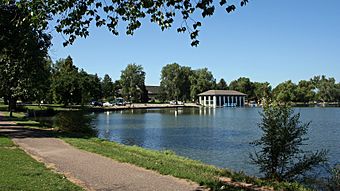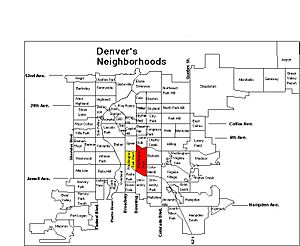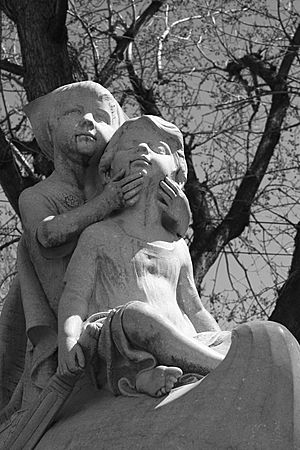Washington Park, Denver facts for kids
Quick facts for kids |
|
|
Washington Park
|
|

Smith Lake and the 1913 Boat House in Washington Park in Denver.
|
|
| Lua error in Module:Location_map at line 420: attempt to index field 'wikibase' (a nil value). | |
| Location | Denver, Colorado |
|---|---|
| Built | 1899 |
| Architect | Reinhard Schuetze, among others |
| Architectural style | Prairie School, Bungalow/Craftsman, Italianate |
| NRHP reference No. | 86002238 |
| Added to NRHP | September 17, 1986 |
Washington Park is a popular neighborhood and public urban park in Denver, Colorado. It's a mix of old and new styles, with historic buildings, pretty lakes, and lots of green spaces.
The park offers many fun things to do, like playing tennis, relaxing on the lawns, or exploring the big flower gardens. It also has a recreation center for sports and activities. Reinhard Schuetze first designed the park in 1899. Other famous planners and designers, like the Olmsted Brothers and even the famous "Unsinkable" Molly Brown, helped shape it over the years.
Washington Park is a favorite spot for both tourists and people who live in Denver. Some even compare it to New York City's Central Park! Besides jogging, walking, or biking, the park is a great place for community events. Because it's so welcoming and special, the American Planning Association named Washington Park one of the "Great Public Spaces in America" in 2012.
Contents
Exploring Washington Park's Location
Washington Park is located in the south-central part of Denver. It's a long, rectangular park. On the north, it's bordered by Virginia Avenue, on the west by Downing Street, on the south by Louisiana Avenue, and on the east by Franklin Street.
The park is about one mile long and a quarter-mile wide. It covers about 165 acres (0.67 km²), making it one of Denver's largest parks.
The area around the park is often called "Wash Park." This neighborhood is actually split into two parts: Washington Park West and the main Washington Park. The public park itself sits between these two neighborhoods.
Inside the park, you'll find two lakes, ten tennis courts, and a large open field perfect for sports like volleyball and soccer. There's also a lawn bowling green, two of Denver's biggest flower gardens, and the city's busiest recreation center.
The History of Washington Park
Washington Park was first designed by a German landscape architect named Reinhard Schuetze. He worked on it between 1899 and 1908. Many parts of his original design are still there today. This includes Smith and Grasmere lakes, and the Lily Pond. These water features were fed by a city ditch that Schuetze lined with willow trees and other plants. He also designed the large open meadow south of Smith Lake and the winding paths for carriages.
Later landscape architects added their own ideas. Saco Rienk DeBoer and Frederick Law Olmsted, Jr. helped make the park even more beautiful. They added the elegant boating pavilion and a grove of evergreen trees on the north side of the park.
The neighborhood around Washington Park started to grow soon after Denver was founded. By 1886, the area had enough people to form Denver's first suburb, South Denver. However, due to money problems in the 1890s, South Denver became part of the city of Denver. The neighborhood grew much faster after the park was created in 1899. Most of the brick houses in the area were built between 1900 and 1940.
In 1908, city planner George Kessler introduced new paths and plants, giving the park a French country style. The DeBoer architects finished the big Perennial Garden in 1918 and the Mt. Vernon Gardens in 1926. The Olmsted Brothers designed the rolling Evergreen Hill and improved the walking paths. They also built the Lily Pond in 1912.
The beautiful boating pavilion, built in 1913, was designed by Jacques Benedict in an Italian style. A swimming area was added to Smith Lake in 1911. Bridges for walkers and cars over the City Ditch were installed by architect F.W. Ameter in 1912.
The home of poet and journalist Eugene Field was moved to the park's northwest edge in 1930. This move was arranged by the famous Titanic survivor and helper, Molly Brown. Field was a reporter for the Denver Tribune from 1881 to 1883. He is best known for his children's poems. Years after Field left Denver, Molly Brown bought his old house and gave it to the city. It was moved to the east side of Washington Park and restored. For many years, it was the Eugene Field Branch of the Denver Public Library.
Field is also remembered by a statue created by Mabel Landrum Torrey. It shows characters from one of his most famous poems, "Wynken, Blynken and Nod". In the 1970s, the house became the office for a group called the Park People. The library moved to a new building nearby.
Since the late 1990s, Washington Park has become a very popular neighborhood. This is because it's close to the city center, right next to the park, and has easy access to many shops and businesses. This popularity has led to some changes in the neighborhood. Some residents worry about more people living there, more traffic, and developers changing or tearing down historic homes.
What Makes Washington Park Special?
The park has several trails, including one that goes all the way around its edge. There are also tennis courts, a field for lawn bowling and croquet, and two playgrounds. A recreation center with an indoor pool, weights, and other sports facilities is also located in the park. The boathouse at Smith Lake can be rented for different events.
Washington Park connects to the rest of the city through bike trails at Exposition Avenue, Marion Street, and Louisiana Avenue. The paths, made of asphalt and gravel, are used by many people. You'll see bicyclists, walkers, rollerbladers, skateboarders, people with strollers, dog walkers, and even people renting surrey bikes. The trees planted around the park offer great views of the Front Range mountains to the west.
The park is also famous for having Denver's largest flower garden, built in 1917. It was a Victorian-style Perennial Garden with an oval lawn and flowerbeds arranged in a perfect pattern. It once had 15,000 different kinds of flowers! Today, it has 54 flowerbeds arranged more informally. One garden is an exact copy of Martha Washington's garden at Mt. Vernon.
Some of the art in the park includes the "Wynken, Blynken and Nod" statue by Mabel Torrey, which honors poet Eugene Field (created in 1919). There's also George Carlson's bronze statue called "Early Day Miner," which shows local history (created in 1980).
The Washington Park neighborhood is one of Denver's oldest. It has many brick houses from the early 1900s and even some from the late 1800s in West Washington Park. There are several shopping areas in the neighborhood, like South Gaylord Street and Alameda Avenue. You can also find smaller corner stores where old streetcar stops used to be. Sometimes, the South Pearl Street area, which is actually in the nearby Platt Park neighborhood, is mistakenly thought to be part of Washington Park.
The neighborhood is next to I-25, a major highway that was expanded in 2006. This highway also includes the RTD light rail system. The Louisiana/Pearl station and University of Denver stations connect the southern part of Washington Park to the light rail. The Broadway station serves West Washington Park. The south end of the park also borders South High School.
Keeping Washington Park Beautiful
A special plan was made in 2003 to help preserve the park's landscape and buildings. This plan was updated in March 2011. A budget of $1.5 million was set aside to fix up the park's south entrance, the picnic area at Mt. Vernon gardens, and the City Ditch.
The main goals for taking care of the park include protecting its historic design, features, buildings, and plants. Other work involves restoring the clear edges of the park's open spaces and bringing back tree groves, paths, and the natural shape of the land that defines these areas. It was also suggested to keep the road around the park as an important feature, but to change it to better suit people walking and biking.
To save water, meadow areas in the park were planned to be restored with native grasses and wildflowers. The goal for the lake shores was to bring back their historic design. The City Ditch was also to be fixed to carry water as it did in the past. Other goals included reusing irrigation water through the city ditch system and saving water in the swimming pool, showers, and faucets. Most of these efforts aim to solve problems like conflicts between walkers, bikers, and drivers, keeping the park's plants diverse, and improving water quality.



